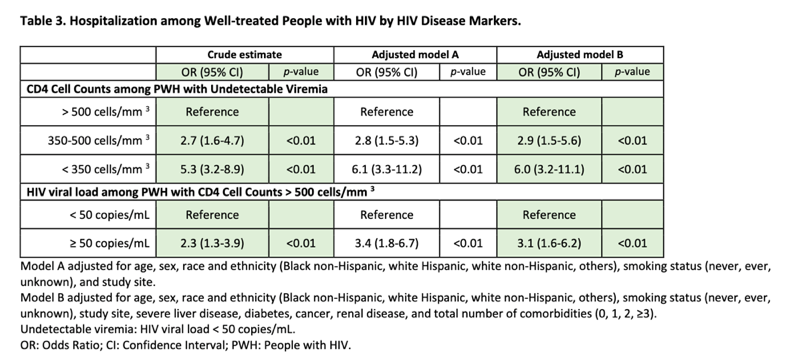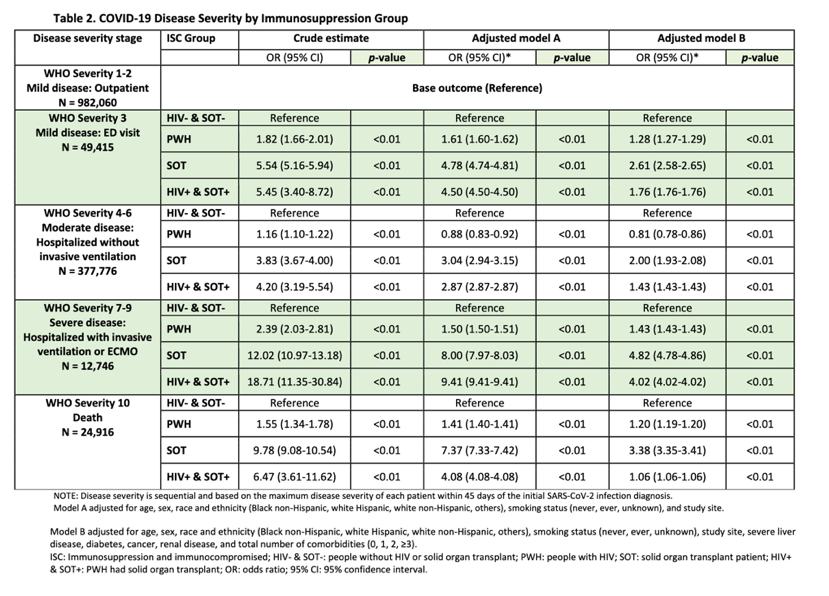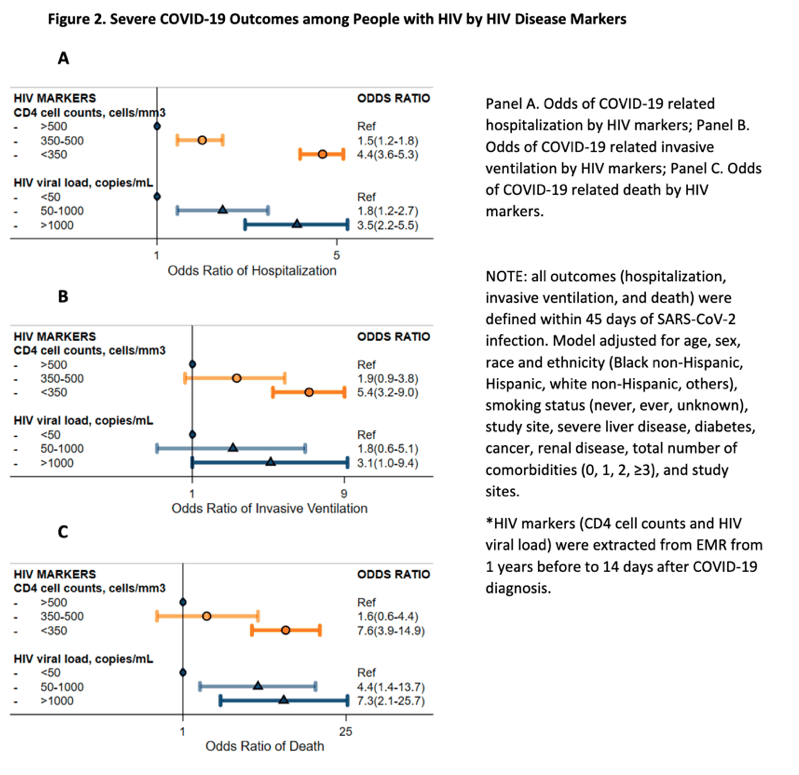| |
COVID-19 Disease Severity among People with HIV Infection or Solid Organ Transplant in the United States: A Nationally-representative, Multicenter, Observational Cohort Study
|
| |
| |
Download the PDF here
Posted July 28, 2021.
Jing Sun, Rena C. Patel, Qulu Zheng, Vithal Madhira, Amy L. Olex, Jessica Y. Islam, Evan French, Teresa Po-Yu Chiang, Hana Akselrod, Richard Moffitt, G. Caleb Alexander, Kathleen M. Andersen, Amanda J. Vinson, Todd T. Brown, Christopher G. Chute, Keith A. Crandall, Nora Franceschini, Roslyn B. Mannon, Gregory D. Kirk, National COVID Cohort Collaborative (N3C) Consortium
"Among PWH, the degree of immunodeficiency and detectable HIV viremia were both independently associated with greater risk for severe COVID-19 disease."
This article is a preprint and has not been peer-reviewed [what does this mean?]. It reports new medical research that has yet to be evaluated and so should not be used to guide clinical practice.
"Compared to PWH with CD4>500 cells/mm3, PWH with CD4<350 cells/mm3 were independently at 4.4-, 5.4-, and 7.6-times higher odds for hospitalization, requiring ventilation, and death"

Our analysis of approximately 1.5 million U.S. patients, is among the largest and most representative multicenter cohort of COVID-19 patients assembled reflective of the U.S. pandemic to date 17,18
Whether PWH have elevated risk of severe COVID-19 disease has been under debate, and previous studies provided conflicting evidence on the association of HIV infection with COVID-19 severity 9,15,16,24-28. Our results add to a growing body of evidence 13,28-31suggesting that PWH, indeed, have an independent increased risk for severe COVID-19 compared to the general population. One hypothesis had been that HIV populations were overrepresented with vulnerable populations to COVID-19, including increased prevalence of minorities, lower socioeconomic status, current smokers, and with substantial comorbidity. However, in sequential analysis, we continued to observe independent associations of HIV infection after adjustment for demographic variables and smoking status, as well as comorbidity burden.
Both PWH or SOT had increased odds of severe COVID-19 outcomes, including requiring invasive ventilation/ECMO and death. The odds for severe disease were substantially driven by, though still independent of, sociodemographic variables and comorbidity burden. Among PWH, the degree of immunodeficiency and detectable HIV viremia were both independently associated with greater risk for severe COVID-19 disease. These data reveal that ISC patients are highly susceptible to severe COVID-19 and emphasize the need for identifying and implementing appropriate strategies for the prevention and management of COVID-19 disease among persons with immune dysfunction.
- In conclusion....Immune dysfunction was associated with elevated risk of severe outcomes independent of age, smoking, and comorbidity burden. Among PWH, risk was further driven by advanced HIV disease. These results call for urgent action for targeted vaccine rollout and potential booster vaccinations among ISC patients. They also call for early treatment, close monitoring for disease progression, as well as pharmaceutical and non-pharmaceutical interventions to reduce COVID-19 risk among ISC patients during the on-going global COVID-19 pandemic.
Our results call for urgent action to administer the SARS-CoV-2 vaccine to PWH to the U.S. and global population, especially targeting those individuals with poorly controlled HIV infection and those living in geographic regions where vaccine uptake among the general public has been lower 36
Globally, these data provide the impetus to prioritize PWH for SARS-CoV-2 vaccination and consideration for early treatment where available, given the vulnerability this group faces for severe COVID-19 outcomes. Again, existing HIV care and prevention infrastructure (PEPFAR, Global Fund) will need to be leveraged to effectively reach this target population.
- Immune-dysregulation and reduced immune response to SARS-CoV-2 among PWH may increase risk of severe outcomes, given CD4 cells play a major role in antiviral immunity. Impaired regulatory T-cell response to SARS-CoV-2 appears to occur among patients with higher disease severity 32. Furthermore, chronic HIV-related inflammation 33,34 and T-cell senescence 35 might heighten the marked inflammatory response/cytokine storm which may intensify organ damage in severe COVID-19 disease. Indeed, our data suggested PWH with higher degree of immune dysfunction and high level of HIV viremia had a dose-dependent higher odds of severe outcomes compared to well-treated PWH. Even among PWH with undetectable viremia or with CD4>500 cells/mm 3, HIV viremia or immune dysfunction were both consistently associated with further risk of COVID-19 related hospitalization.
- The social determinants which impact an individual's ability to successfully engage in HIV care (substance use, mental health, housing stability, comorbidity) may also be overrepresented amongst persons with poor COVID-19 outcomes.
https://www.medrxiv.org/content/10.1101/2021.07.26.21261028v1.full


COVID-19 Disease Severity among PWH and/or SOT
Within 45 days of COVID-19 diagnosis, 67.9% of patients had asymptomatic to mild disease requiring outpatient care only. While only 3.4% were solely evaluated in the ED, 26.1% required hospitalization without invasive ventilation/ECMO, 0.9% required invasive ventilation or ECMO but did not die, and 1.7% died. Figure 1 demonstrated the crude prevalence of COVID-19 disease severity by ISC group. Table 2 showed that patients with HIV, SOT or both had higher odds of more severe disease. Among PWH, adjusted odds ratios (ORs) for ED visits, moderate hospitalization (without invasive ventilation/ECMO), severe hospitalization with invasive ventilation/ECMO, and death were 1.28 (95% CI: 1.27, 1.29), 0.81 (95% CI: 0.78, 0.86), 1.43 (95% CI: 1.43, 1.43), and 1.20 (95% CI: 1.19, 1.20), respectively, compared to people without ISC. Compared to the crude estimates, adjustment for sociodemographic and smoking (Table 2, model A) and comorbidity burden (model B) substantially attenuated the association, but all associations remained significant. Adjustment for study sites resulted in high precision for estimations and produced narrow CI (model A and B). We observed an inverse association for moderate hospitalization (WHO severity 4-6) among PWH in adjusted models A and B, despite a high crude prevalence of PWH compared to the general population (Figure 1). Evaluation of individual covariates in the adjusted models indicated that the reduced odds were mainly driven by high prevalence of smoking and non-White race/ethnicity among PWH.
HIV Markers and COVID-19 Severity
A total of 3,660 PWH with COVID-19 had available CD4 cell counts measurements: 22.9% were <350 cells/mm3, 16.4% were between 350-500 cells/mm3, and 60.7% were >500 cells/mm3. Of 1,424 PWH with available HIV viral load measurements, the majority of them (67.7%) had undetectable viremia (<50 copies/mL), 20.6% had low level viremia (50-1000 copies/mL), and 11.7% had high level viremia (>1,000 copies/mL). Demographic characteristics of individuals with available lab values and all PWH were similar (Supplementary Table S-3).
The associations between advanced HIV disease and COVID-19 outcomes were dose-dependent and independent of sociodemographic, smoking status, and comorbidity burdens (Figure 2. Panel A, B, C). Compared to CD4>500 cells/mm3, levels of <350 cells/mm3 were independently associated with greater odds of hospitalization (OR: 4.4, 95% CI: 3.6, 5.3), invasive ventilation (OR: 5.4, 95% CI: 3.2, 9), and death (OR: 7.6, 95% CI: 3.9, 14.9). Compared to undetectable viremia, viral load of 50-1000 or >1000 copies/mL were independently associated with greater odds of hospitalization (OR: 1.8 CI: 1.2-2.7 and OR: 3.5 CI: 2.2-5.5, respectively) and death (OR: 4.4 CI: 1.4-13.7 and OR: 7.3 CI: 2.1-25.7, respectively). Among PWH with undetectable viremia, lower CD4 cell counts (350-500 and <350 cells/mm 3) was associated with 2.9 and 6-times the odds of hospitalization (Table 3), respectively, compared to higher CD4 cell counts. Among PWH with CD4>500 cells/mm3, detectable viremia is further associated with over 2-fold higher odds of hospitalization. Sensitivity analysis restricted to laboratory values prior to COVID-19 infection yielded consistent results.
|
|
| |
| |
|
|
|